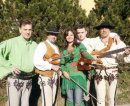Polish Folk
Users contributing to this page: JanMalysiak
Polish folk music was collected in the 19th century by Oskar Kolberg, as part of a wave of Polish national revival. After World War II, in the Polish People's Republic, folk traditions were commonly cultivated, but public performances and broadcasts had also highly organized and officially promoted forms. State-supported, large-scale folk ensembles became prominent. The most famous of these were Mazowsze and Śląsk, both of which still perform. Though such bands presented interpretations of regional folk repertoire, the overall sound was a homogenized mixture of Polish styles. There were more authentic groups, such as Słowianki, but the sanitized image of folk music made the whole field unattractive to some audiences, and many traditions dwindled rapidly.
Polish dance music, especially the mazurka and polonaise, were popularized by Frédéric Chopin, and they soon spread across Europe and elsewhere. These are triple time dances, while five-beat forms are more common in the northeast and duple-time dances like the krakowiak come from the south. The 'polonaise' comes from the French word for 'Polish' used to identify its origin among the Polish aristocracy who had adapted the dance from a slower walking dance called chodzony. The polonaise then re-entered the lower-class musical life, and became an integral part of the Polish music.
-
Kapela ze Wsi Warszawa
-
 Poland
Poland
- 1997-present
-





